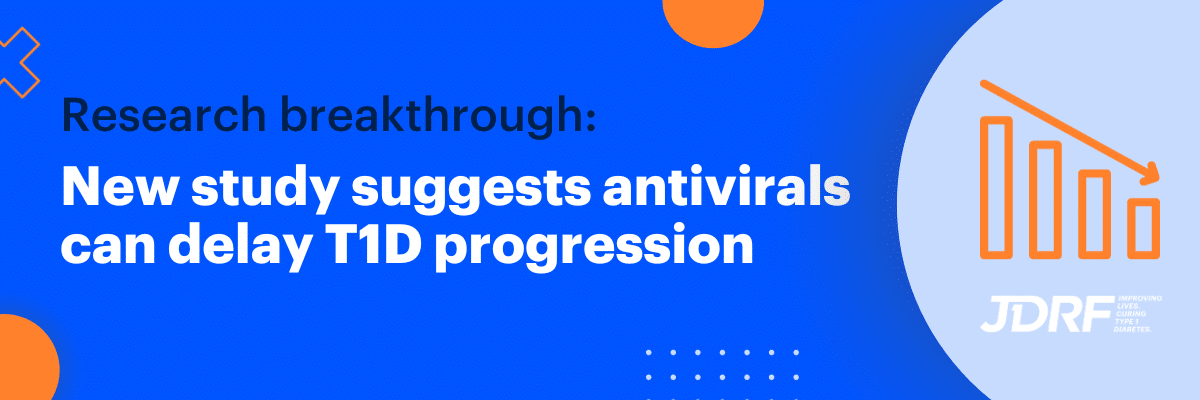Research breakthrough shows that antivirals can delay T1D progression

A new study suggests that giving antivirals shortly after a type 1 diabetes (T1D) diagnosis may preserve the body’s ability to produce insulin.
Recent results from a clinical trial published in the prestigious Nature journal have suggested that administering the antivirals pleconaril and ribavirin can preserve beta cell function in children and teenagers recently diagnosed with T1D, allowing them to produce their own insulin for longer.
The role of viruses in T1D
T1D is an autoimmune condition where the immune system mistakenly attacks the insulin-producing beta cells in the pancreas, leading to their gradual loss and inability to produce insulin. As a result, individuals diagnosed with the condition rely on injecting insulin for the rest of their lives.
We are still unclear of how and why T1D develops, but we believe that environmental factors, including virus infections, trigger or drive T1D progression in those who are genetically susceptible to the condition.
In particular, there is strong evidence that a family of viruses called enteroviruses (especially Coxsackie B enteroviruses) is associated with T1D development. Enterovirus infection is common in childhood and can result in a range of effects ranging from mild to severe illness.
There is therefore increasing research interest, including here in Australia through the JDRF-funded Environmental Determinants of Iselt Autoimmunity (ENDIA) study, to understand how virus infections may lead to T1D development and to investigate therapies such as vaccines and antivirals that can halt T1D in its tracks.
What was the study about?
The Nature study sought to test whether giving the antivirals pleconaril and ribavirin to newly diagnosed children and teenagers would allow them to keep producing more of their own insulin. Pleconaril is an antiviral specific to enteroviruses and ribavirin is a broad-spectrum antiviral though to give pleconaril action a boost.
Specifically, Danish and Norwegian children and teenagers, aged 6 to 15 years, diagnosed with T1D in the previous three weeks, were given either the antivirals or a placebo for 6 months, and then followed up for another 6 months. The researchers primarily wanted to determine if the antiviral treatment would have any effect on the production of insulin, as detected by C-peptide levels (a commonly used marker of insulin production). In addition, they sought to determine how the treatment affected C-peptide levels above a certain threshold, how much injected insulin individuals needed, the level of HbA1c (a marker of long-term blood glucose control), another protein called glycated albumin, and the number of hypoglycaemic events.
What did the study show?
The study showed that those who took the antivirals had higher C-peptide levels and therefore were producing more insulin compared to the placebo group after 12 months. There was no difference in the level of insulin produced at 3 and 6 months of treatment. In addition, the treatment group had lower levels of HbA1c at 3 and 6 months, but not at 12 months. There were no differences in any of the other measures including the amount of insulin they needed to inject. Importantly, here were no safety concerns from the use of the antivirals.
What does this mean for those newly diagnosed and what’s next?
Upon T1D diagnosis, people may still have considerable numbers of beta cells left, so current research is now focusing on how to preserve these remaining beta cells so that they can continue to produce insulin. This should have health benefits such as making it easier to control blood sugar levels and avoiding long-term complications.
The current study suggests that treating people with antivirals shortly after diagnosis can slow the decline in insulin production in those newly diagnosed.
However, this was a relatively small study which needs further research. The authors suggest that further follow up for 3 years will need to be undertaken to see if the effect of the antiviral treatment is maintained in the longer term. They also suggest replicating the study using more people, with different ages, countries and at different stages of T1D development. In particular, the authors are interested in testing the antivirals in the pre-symptomatic stages of T1D, before diagnosis occurs as there is likely to be more beta cells alive to preserve.
How JDRF is supporting similar work in Australia:
JDRF supports major T1D prevention initiatives in Australia. The ENDIA study, led by Professor Jenny Couper from the Adelaide Women’s and Children’s Hospital and University of Adelaide, is a world first project looking how the environment may contribute to the onset of T1D from as early as pregnancy. ENDIA is a nationwide study involving 1,500 mothers and infants with a first degree relative with T1D.
Part of this study being led by Professor Maria Craig and Dr Ki Wook Kim, in collaboration Professor William Rowlinson, is focusing on whether early infection by viruses during pregnancy and infancy increases the risk of developing T1D. Dr Kim is looking at all the viruses women are exposed to during pregnancy, to see if this affects the chance of their child developing T1D. The ultimate goal of Dr Kim’s work is to develop vaccines to prevent T1D, as well as antiviral therapeutics like those in the Nature study to potentially treat people already diagnosed with T1D.

“These latest findings regarding the antivirals pleconaril and ribavirin in T1D are incredibly exciting. They demonstrate that antivirals may be a viable option for delaying the progress of T1D and eventually stop it from developing all together. The field of T1D detection and prevention is advancing rapidly and there are many potential therapeutic options being tested in laboratories all around the world, including right here in Australia”
Dr Ki Wool Kim, University of NSW, part of the ENDIA study team
Our research portfolio
Groundbreaking projects like these are only possible with support from our community. The future of 130,000 Australians living with T1D and the 8 more diagnosed each day depends on it.
To get involved, donate here.
Explore all research projects that JDRF Australia funds.




